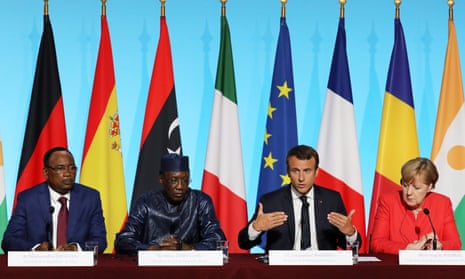Migration remains at the heart of Europe’s political and social crisis. Instability in Africa and elsewhere, wars, persecution, poverty, demographic trends and the ancient human urge to seek a better life in safer, more prosperous regions, all mean that this reality is not about to change. Two years after more than a million people made their way to Europe in the largest arrival of migrants from outside the continent in its history, European institutions and governments still struggle to find solutions. Even when sound policies are crafted, such as relocation sharing, to alleviate the pressure on “frontline” states, implementation lags far behind.
On Monday the leaders of several European and African states – the UK not among them – met in Paris to try to forge more unity on how to address both the humanitarian urgency and the root causes of migration. The talks centred on stemming migration flows closer to their source. This makes sense, but only if the rights of migrants who need urgent protection are respected. Europe’s strategies must not amount to pushing the problem further away from its shores, rather than trying to solve it.
The tragedies in the Mediterranean are far from over, but now the hazards of migration are shifting further south into the deserts of the Sahara and the Sahel. The EU is pushing African governments to clamp down on traffickers’ networks and to tighten control over key border areas. Conditions have been attached to the disbursement of development aid, particularly to encourage repression of traffickers. The EU has pledged €640m for such programmes in Niger alone, with some positive results. The International Organization for Migration notes a steep drop in the numbers of people crossing from Niger into Libya since 2016.
These regions are thus becoming Europe’s new frontier against sub-Saharan migrants and refugees travelling towards the central Mediterranean. In 2016, more than 160,000 people took this route to Italy, mainly on makeshift boats. A thinktank, International Crisis Group, estimates that people-smuggling through Libya generates annual revenues of between $1bn and $1.5bn.
Yet blocking off routes does little to prevent others from being used, sometimes in even more dangerous circumstances. Recently there have been reports of traffickers abandoning their human cargo in the middle of the desert. This happens when they fear arrest by local security forces, or if vehicles break down. Migrants are then left stranded in the sand without water, food or shelter, in blisteringly hot temperatures. The overall number of deaths is hard to quantify, just as it is in the sea, but observers believe such brutality has become more frequent. UN agencies and NGOs have been sounding alarm bells.
In the two years since the EU launched its “agenda on migration”, there have been results to show, but the overall picture remains a bleak one. After the Balkan route was cut by the EU-Turkey agreement in 2016, equally controversial efforts have focused on working with the Libyan coastguard, and even on curbing the work of NGO ships that have been accused of creating a pull factor.
Europe is in effect externalising its migration problem to African countries, after partly outsourcing it to Turkey. Yet as migration routes shift, the human tragedies simply go with them.
The only genuinely sustainable and humane solution would be to create safe, legal pathways for asylum seekers, but this has been largely shunned by nervous politicians, as is happening in Italy. Helping to stabilise and develop countries that are haemorrhaging their youth for lack of economic opportunity or basic security unquestionably requires a long-term effort. But stemming the movement of people by trying to build more barriers means that Europe’s policies are failing to match its stated values. Insisting that African governments or militias return desperate people to places where their lives are in danger is even worse.
Sending back migrants who are not entitled to asylum is a necessary policy. But it must be done in a humane fashion, after due process, and only when the policy is sustainably safe. The idea of establishing EU “hotspots” in highly dangerous places like Libya must be abandoned. Meanwhile, closer attention must be paid to what is unfolding in the desert, and resources put into rescue operations. The fact that many of these tragedies are unfolding far from European eyes does not justify inaction.
